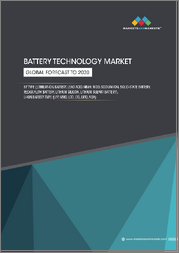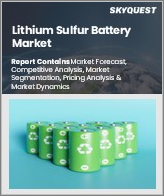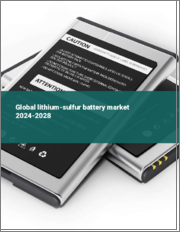
|
시장보고서
상품코드
1683243
세계의 리튬 황 배터리 시장 조사 보고서 : 산업 분석, 규모, 점유율, 성장, 동향, 예측(2025-2033년)Global Lithium Sulfur Battery Market Research Report- Industry Analysis, Size, Share, Growth, Trends and Forecast 2025 to 2033 |
||||||
세계의 리튬 황 배터리 시장 규모는 2024년 14억 7,000만 달러에서 2033년에는 46억 8,000만 달러로 성장하며, 2026-2033년의 예측 기간 중 13.73%의 견고한 연평균 성장률(CAGR)을 보일 것으로 예측됩니다.
세계 리튬황 배터리 시장은 전기자동차 및 재생에너지 시스템 등 다양한 용도에서 고에너지 밀도 에너지 저장 솔루션에 대한 수요가 증가함에 따라 급성장하고 있습니다. 리튬유황 배터리는 기존 리튬이온 배터리보다 높은 이론적 에너지 밀도, 낮은 재료비 등 몇 가지 장점을 가지고 있으며, 비용을 줄이면서 성능을 높이고자 하는 제조업체들에게 매력적인 선택지가 되고 있습니다. 지속가능한 에너지 솔루션의 추진이 강화됨에 따라 리튬황 기술의 채택이 가속화되고 이 유망한 부문에 대한 혁신과 투자가 촉진될 것으로 예상됩니다.
또한 배터리 기술과 재료 과학의 발전은 리튬 황 배터리 시장을 발전시킬 것입니다. 연구자들은 사이클 안정성 및 황 이용과 같은 문제를 극복하기 위한 새로운 접근 방식을 적극적으로 모색하고 있습니다. 첨단 전해질, 전도성 첨가제, 혁신적인 양극 설계의 개발은 성능과 수명을 향상시킬 수 있는 길을 열어주고 있습니다. 이러한 기술적 혁신이 실현되면 에너지 저장 및 전기 이동성에 리튬유황 배터리의 장점을 활용하고자 하는 산업계 수요가 급증할 가능성이 높습니다.
또한 세계 리튬유황전지 시장은 청정에너지 기술 촉진을 위한 정부 지원 정책 및 구상의 수혜를 받을 것으로 예상됩니다. 각국이 야심찬 기후 변화 목표를 달성하고 온실 가스 배출량을 줄이기 위해 노력함에 따라 배터리 연구개발에 대한 투자가 점점 더 우선순위가 높아지고 있습니다. 리튬유황 배터리의 상용화를 촉진하고 이 혁신적인 기술이 지속가능한 에너지 미래로의 전환에 중요한 역할을 할 수 있도록 하기 위해서는 산업 이해관계자, 연구기관 및 정부기관의 협력이 필수적입니다.
당사의 보고서는 고객에게 다양한 산업과 시장에 대한 종합적이고 실용적인 인사이트를 제공할 수 있도록 세심하게 작성되었습니다. 각 보고서는 시장 상황을 완전히 이해하기 위해 몇 가지 중요한 요소를 포함하고 있습니다.
시장 개요 : 정의, 분류, 산업 현황 등 시장에 대한 자세한 소개.
시장 성장 촉진요인 : 시장 성장에 영향을 미치는 주요 촉진요인, 억제요인, 시장 성장 촉진요인 및 과제를 상세하게 분석합니다. 이 섹션에서는 기술 발전, 규제 변화, 새로운 동향 등의 요인을 검토합니다.
세분화 분석 : 제품 유형, 애플리케이션, 최종사용자, 지역 등의 기준에 따라 시장을 명확한 부문으로 분류합니다. 이 분석을 통해 각 부문의 성과와 잠재력을 파악할 수 있습니다.
경쟁상황 : 시장 점유율, 제품 포트폴리오, 전략적 구상, 재무실적 등 주요 시장 진입기업에 대한 종합적인 평가. 주요 기업이 채택하고 있는 경쟁 역학 및 주요 전략에 대한 인사이트이 포함되어 있습니다.
시장 예측 : 과거 데이터와 현재 시장 상황을 바탕으로 일정 기간 중 시장 규모와 성장 추세를 예측합니다. 여기에는 정량적 분석과 미래 시장 궤적을 나타내는 그래프 표시가 포함됩니다.
지역 분석 : 지역별 시장 성과를 평가하고 주요 시장 및 지역 동향을 파악할 수 있습니다. 지역 시장 역학 및 비즈니스 기회를 이해하는 데 도움이 됩니다.
새로운 동향과 기회 : 현재 시장 동향과 새로운 시장 동향, 기술 혁신, 잠재적 투자 대상 부문을 식별합니다. 미래 시장 개발 및 성장 전망에 대한 인사이트를 제공합니다.
목차
제1장 서문
제2장 개요
- 시장의 하이라이트
- 세계 시장 스냅숏
제3장 리튬 황 배터리 산업 분석
- 서론 : 시장 역학
- 시장 성장 촉진요인
- 시장 성장 억제요인
- 시장 기회
- 산업 동향
- Porter's Five Forces 분석
- 시장의 매력 분석
제4장 밸류체인 분석
- 밸류체인 분석
- 원료 분석
- 원료 리스트
- 원료 제조업체 리스트
- 주요 원료의 가격 동향
- 잠재적 바이어 리스트
- 마케팅 채널
- 직접 마케팅
- 간접 마케팅
- 마케팅 채널 발전 동향
제5장 세계의 리튬 황 배터리 시장 분석 : 제품 유형별
- 제품 유형별 개요
- 제품 유형별 과거·예측 데이터 분석
- 고에너지 밀도
- 긴 주기 수명
- 저비용
제6장 세계의 리튬 황 배터리 시장 분석 : 용도별
- 용도별 개요
- 용도별 과거·예측 데이터 분석
- 자동차
- 항공우주
- 가전제품
- 에너지 저장 시스템
- 기타
제7장 세계의 리튬 황 배터리 시장 분석 : 최종사용자별
- 최종사용자별 개요
- 최종사용자별 과거·예측 데이터 분석
- 전기자동차
- 휴대용 일렉트로닉스
- 그리드 스토리지
- 기타
제8장 세계의 리튬 황 배터리 시장 분석 : 지역별
- 지역별 전망
- 서론
- 북미의 판매 분석
- 개요, 실적과 예측
- 북미 : 부문별
- 북미 : 국가별
- 미국
- 캐나다
- 멕시코
- 유럽 판매 분석
- 개요, 실적과 예측
- 유럽 : 부문별
- 유럽 : 국가별
- 영국
- 프랑스
- 독일
- 이탈리아
- 러시아
- 기타 유럽
- 아시아태평양 판매 분석
- 개요, 실적과 예측
- 아시아태평양 : 부문별
- 아시아태평양 : 국가별
- 중국
- 인도
- 일본
- 한국
- 호주
- 동남아시아
- 기타 아시아태평양
- 라틴아메리카 판매 분석
- 개요, 실적과 예측
- 라틴아메리카 : 부문별
- 라틴아메리카 : 국가별
- 브라질
- 아르헨티나
- 페루
- 칠레
- 기타 라틴아메리카
- 중동 및 아프리카 판매 분석
- 개요, 실적과 예측
- 중동 및 아프리카 : 부문별
- 중동 및 아프리카 : 국가별 리스트
- 사우디아라비아
- 아랍에미리트
- 이스라엘
- 남아프리카공화국
- 기타 중동 및 아프리카
제9장 리튬 황 배터리 기업의 경쟁 구도
- 리튬 황 배터리 시장의 경쟁
- 제휴·협업·계약
- 합병·인수
- 신제품 발매
- 기타 개발
제10장 기업 개요
- 상위 기업의 시장 점유율 분석
- 시장 집중도
- Samsung SDI
- LG Chem
- Panasonic Corporation
- Johnson Controls International Plc
- Saft Groupe S.A.
- Hitachi Chemical Co. Ltd.
- EnerDel Inc.
- Amprius Technologies
- SolidEnergy Systems
- Sion Power Corporation
- Mullen Technologies
- OXIS Energy Ltd.
- PolyPlus Battery Company
- BrightVolt Inc.
- LeydenJar Technologies
Global Lithium Sulfur Battery Market size is anticipated to grow from USD 1.47 Billion in 2024 to USD 4.68 Billion by 2033, showcasing a robust Compound Annual Growth Rate (CAGR) of 13.73% during the forecast period of 2026 to 2033.
The global lithium-sulfur battery market is poised for remarkable growth, driven by the increasing demand for high-energy-density storage solutions in various applications, including electric vehicles and renewable energy systems. Lithium-sulfur batteries offer several advantages over traditional lithium-ion batteries, such as higher theoretical energy density and lower material costs, making them an attractive alternative for manufacturers seeking to enhance performance while reducing expenses. As the push for sustainable energy solutions intensifies, the adoption of lithium-sulfur technology is expected to accelerate, fostering innovation and investment in this promising sector.
Moreover, advancements in battery technology and materials science are set to propel the lithium-sulfur battery market forward. Researchers are actively exploring novel approaches to overcome challenges such as cycle stability and sulfur utilization, which have historically hindered the commercial viability of these batteries. The development of advanced electrolytes, conductive additives, and innovative cathode designs is paving the way for improved performance and longevity. As these technological breakthroughs materialize, the market is likely to witness a surge in demand from industries looking to leverage the benefits of lithium-sulfur batteries for energy storage and electric mobility.
In addition, the global lithium-sulfur battery market is expected to benefit from supportive government policies and initiatives aimed at promoting clean energy technologies. As countries strive to meet ambitious climate goals and reduce greenhouse gas emissions, investments in battery research and development are becoming increasingly prioritized. Collaborative efforts between industry stakeholders, research institutions, and government entities will be crucial in driving the commercialization of lithium-sulfur batteries, ensuring that this innovative technology plays a vital role in the transition to a sustainable energy future.
Our reports are meticulously crafted to provide clients with comprehensive and actionable insights into various industries and markets. Each report encompasses several critical components to ensure a thorough understanding of the market landscape:
Market Overview: A detailed introduction to the market, including definitions, classifications, and an overview of the industry's current state.
Market Dynamics: In-depth analysis of key drivers, restraints, opportunities, and challenges influencing market growth. This section examines factors such as technological advancements, regulatory changes, and emerging trends.
Segmentation Analysis: Breakdown of the market into distinct segments based on criteria like product type, application, end-user, and geography. This analysis highlights the performance and potential of each segment.
Competitive Landscape: Comprehensive assessment of major market players, including their market share, product portfolio, strategic initiatives, and financial performance. This section provides insights into the competitive dynamics and key strategies adopted by leading companies.
Market Forecast: Projections of market size and growth trends over a specified period, based on historical data and current market conditions. This includes quantitative analyses and graphical representations to illustrate future market trajectories.
Regional Analysis: Evaluation of market performance across different geographical regions, identifying key markets and regional trends. This helps in understanding regional market dynamics and opportunities.
Emerging Trends and Opportunities: Identification of current and emerging market trends, technological innovations, and potential areas for investment. This section offers insights into future market developments and growth prospects.
SEGMENTATION COVERED IN THE REPORT
By Product Type
- High Energy Density
- Long Cycle Life
- Low Cost
By Application
- Automotive
- Aerospace
- Consumer Electronics
- Energy Storage Systems
- Others
By End-User
- Electric Vehicles
- Portable Electronics
- Grid Storage
- Others
- COMPANIES PROFILED
- Samsung SDI
- LG Chem
- Panasonic Corporation
- Johnson Controls International plc
- Saft Groupe S.A.
- Hitachi Chemical Co. Ltd.
- EnerDel Inc.
- Amprius Technologies
- SolidEnergy Systems
- Sion Power Corporation
- Mullen Technologies
- OXIS Energy Ltd.
- PolyPlus Battery Company
- BrightVolt Inc.
- LeydenJar Technologies
- The above list can be customized.
TABLE OF CONTENTS
1. PREFACE
- 1.1. Report Description
- 1.1.1 Objective
- 1.1.2 Target Audience
- 1.1.3 Unique Selling Proposition (USP) & offerings
- 1.2. Research Scope
- 1.3. Research Methodology
- 1.3.1 Market Research Process
- 1.3.2 Market Research Methodology
2. EXECUTIVE SUMMARY
- 2.1. Highlights of Market
- 2.2. Global Market Snapshot
3. LITHIUM SULFUR BATTERY INDUSTRY ANALYSIS
- 3.1. Introduction - Market Dynamics
- 3.2. Market Drivers
- 3.3. Market Restraints
- 3.4. Opportunities
- 3.5. Industry Trends
- 3.6. Porter's Five Force Analysis
- 3.7. Market Attractiveness Analysis
- 3.7.1 Market Attractiveness Analysis By Product Type
- 3.7.2 Market Attractiveness Analysis By Application
- 3.7.3 Market Attractiveness Analysis By End-User
- 3.7.4 Market Attractiveness Analysis By Region
4. VALUE CHAIN ANALYSIS
- 4.1. Value Chain Analysis
- 4.2. Raw Material Analysis
- 4.2.1 List of Raw Materials
- 4.2.2 Raw Material Manufactures List
- 4.2.3 Price Trend of Key Raw Materials
- 4.3. List of Potential Buyers
- 4.4. Marketing Channel
- 4.4.1 Direct Marketing
- 4.4.2 Indirect Marketing
- 4.4.3 Marketing Channel Development Trend
5. GLOBAL LITHIUM SULFUR BATTERY MARKET ANALYSIS BY PRODUCT TYPE
- 5.1. Overview By Product Type
- 5.2. Historical and Forecast Data Analysis By Product Type
- 5.3. High Energy Density Historic and Forecast Sales By Regions
- 5.4. Long Cycle Life Historic and Forecast Sales By Regions
- 5.5. Low Cost Historic and Forecast Sales By Regions
6. GLOBAL LITHIUM SULFUR BATTERY MARKET ANALYSIS BY APPLICATION
- 6.1. Overview By Application
- 6.2. Historical and Forecast Data Analysis By Application
- 6.3. Automotive Historic and Forecast Sales By Regions
- 6.4. Aerospace Historic and Forecast Sales By Regions
- 6.5. Consumer Electronics Historic and Forecast Sales By Regions
- 6.6. Energy Storage Systems Historic and Forecast Sales By Regions
- 6.7. Others Historic and Forecast Sales By Regions
7. GLOBAL LITHIUM SULFUR BATTERY MARKET ANALYSIS BY END-USER
- 7.1. Overview By End-User
- 7.2. Historical and Forecast Data Analysis By End-User
- 7.3. Electric Vehicles Historic and Forecast Sales By Regions
- 7.4. Portable Electronics Historic and Forecast Sales By Regions
- 7.5. Grid Storage Historic and Forecast Sales By Regions
- 7.6. Others Historic and Forecast Sales By Regions
8. GLOBAL LITHIUM SULFUR BATTERY MARKET ANALYSIS BY GEOGRAPHY
- 8.1. Regional Outlook
- 8.2. Introduction
- 8.3. North America Sales Analysis
- 8.3.1 Overview, Historic and Forecast Data Sales Analysis
- 8.3.2 North America By Segment Sales Analysis
- 8.3.3 North America By Country Sales Analysis
- 8.3.4 United States Sales Analysis
- 8.3.5 Canada Sales Analysis
- 8.3.6 Mexico Sales Analysis
- 8.4. Europe Sales Analysis
- 8.4.1 Overview, Historic and Forecast Data Sales Analysis
- 8.4.2 Europe By Segment Sales Analysis
- 8.4.3 Europe By Country Sales Analysis
- 8.4.4 United Kingdom Sales Analysis
- 8.4.5 France Sales Analysis
- 8.4.6 Germany Sales Analysis
- 8.4.7 Italy Sales Analysis
- 8.4.8 Russia Sales Analysis
- 8.4.9 Rest Of Europe Sales Analysis
- 8.5. Asia Pacific Sales Analysis
- 8.5.1 Overview, Historic and Forecast Data Sales Analysis
- 8.5.2 Asia Pacific By Segment Sales Analysis
- 8.5.3 Asia Pacific By Country Sales Analysis
- 8.5.4 China Sales Analysis
- 8.5.5 India Sales Analysis
- 8.5.6 Japan Sales Analysis
- 8.5.7 South Korea Sales Analysis
- 8.5.8 Australia Sales Analysis
- 8.5.9 South East Asia Sales Analysis
- 8.5.10 Rest Of Asia Pacific Sales Analysis
- 8.6. Latin America Sales Analysis
- 8.6.1 Overview, Historic and Forecast Data Sales Analysis
- 8.6.2 Latin America By Segment Sales Analysis
- 8.6.3 Latin America By Country Sales Analysis
- 8.6.4 Brazil Sales Analysis
- 8.6.5 Argentina Sales Analysis
- 8.6.6 Peru Sales Analysis
- 8.6.7 Chile Sales Analysis
- 8.6.8 Rest of Latin America Sales Analysis
- 8.7. Middle East & Africa Sales Analysis
- 8.7.1 Overview, Historic and Forecast Data Sales Analysis
- 8.7.2 Middle East & Africa By Segment Sales Analysis
- 8.7.3 Middle East & Africa By Country Sales Analysis
- 8.7.4 Saudi Arabia Sales Analysis
- 8.7.5 UAE Sales Analysis
- 8.7.6 Israel Sales Analysis
- 8.7.7 South Africa Sales Analysis
- 8.7.8 Rest Of Middle East And Africa Sales Analysis
9. COMPETITIVE LANDSCAPE OF THE LITHIUM SULFUR BATTERY COMPANIES
- 9.1. Lithium Sulfur Battery Market Competition
- 9.2. Partnership/Collaboration/Agreement
- 9.3. Merger And Acquisitions
- 9.4. New Product Launch
- 9.5. Other Developments
10. COMPANY PROFILES OF LITHIUM SULFUR BATTERY INDUSTRY
- 10.1. Top Companies Market Share Analysis
- 10.2. Market Concentration Rate
- 10.3. Samsung SDI
- 10.3.1 Company Overview
- 10.3.2 Company Revenue
- 10.3.3 Products
- 10.3.4 Recent Developments
- 10.4. LG Chem
- 10.4.1 Company Overview
- 10.4.2 Company Revenue
- 10.4.3 Products
- 10.4.4 Recent Developments
- 10.5. Panasonic Corporation
- 10.5.1 Company Overview
- 10.5.2 Company Revenue
- 10.5.3 Products
- 10.5.4 Recent Developments
- 10.6. Johnson Controls International Plc
- 10.6.1 Company Overview
- 10.6.2 Company Revenue
- 10.6.3 Products
- 10.6.4 Recent Developments
- 10.7. Saft Groupe S.A.
- 10.7.1 Company Overview
- 10.7.2 Company Revenue
- 10.7.3 Products
- 10.7.4 Recent Developments
- 10.8. Hitachi Chemical Co. Ltd.
- 10.8.1 Company Overview
- 10.8.2 Company Revenue
- 10.8.3 Products
- 10.8.4 Recent Developments
- 10.9. EnerDel Inc.
- 10.9.1 Company Overview
- 10.9.2 Company Revenue
- 10.9.3 Products
- 10.9.4 Recent Developments
- 10.10. Amprius Technologies
- 10.10.1 Company Overview
- 10.10.2 Company Revenue
- 10.10.3 Products
- 10.10.4 Recent Developments
- 10.11. SolidEnergy Systems
- 10.11.1 Company Overview
- 10.11.2 Company Revenue
- 10.11.3 Products
- 10.11.4 Recent Developments
- 10.12. Sion Power Corporation
- 10.12.1 Company Overview
- 10.12.2 Company Revenue
- 10.12.3 Products
- 10.12.4 Recent Developments
- 10.13. Mullen Technologies
- 10.13.1 Company Overview
- 10.13.2 Company Revenue
- 10.13.3 Products
- 10.13.4 Recent Developments
- 10.14. OXIS Energy Ltd.
- 10.14.1 Company Overview
- 10.14.2 Company Revenue
- 10.14.3 Products
- 10.14.4 Recent Developments
- 10.15. PolyPlus Battery Company
- 10.15.1 Company Overview
- 10.15.2 Company Revenue
- 10.15.3 Products
- 10.15.4 Recent Developments
- 10.16. BrightVolt Inc.
- 10.16.1 Company Overview
- 10.16.2 Company Revenue
- 10.16.3 Products
- 10.16.4 Recent Developments
- 10.17. LeydenJar Technologies
- 10.17.1 Company Overview
- 10.17.2 Company Revenue
- 10.17.3 Products
- 10.17.4 Recent Developments



















